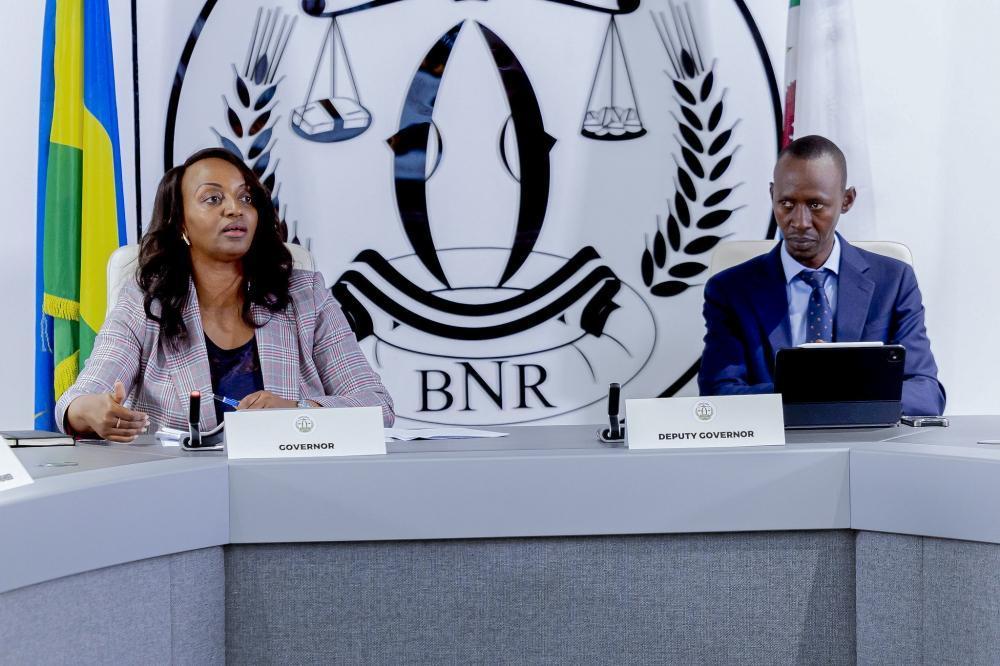Africa-Press – Rwanda. The National Bank of Rwanda (BNR)’s Monetary Policy Committee (MPC) has decided to increase the Central Bank Rate (CBR) – for the next three months – to 6.75 per cent, 25 basis points compared to the previous 6.5 per cent.
BNR officials say this is a level considered adequate to keep inflation within the target range.
This was announced on August 20, in Kigali, during a press conference on MPC and the Financial Stability Committee (FSC) decisions.
The central bank indicated that its lending rate serves as a benchmark for commercial banks, guiding the cost of borrowing and lending. It is the main tool used by BNR to control inflation and support macroeconomic stability.
According to BNR, inflation should be within target band of 2 to 8 per cent, which is considered ideal to maintain price stability.
In the second quarter of 2025, inflation remained within the expected range – of 2 to 8 per cent. It is expected to average around 7.1 per cent this year and decline to about 5.6 per cent in 2026.
However, these projections, which have been revised upward, are prone to inflationary risks, including adverse weather conditions that might affect future agriculture production, international commodity and trade uncertainties that affect global inflation developments, the central bank pointed out.
While in May the central bank had projected that inflation would not exceed 6.5 per cent this year and 3.9 per cent in 2026, the rates were revised upwards based on agricultural output data and other prices that went up in July – including prices of fuel, according to BNR Governor Soraya Hakuziyaremye.
“The small increase in BNR’s lending rate is meant to ensure that we do not reach the level of inflation of 8 per cent for this year and next year,” she said.
“Based on the increase in inflation over the last three years and strategies that were taken to bring it within the [targeted] range, we hope that if we sustain these measures and others that are set by the government to contain price increase, we will not go beyond the 8 per cent limit,” she observed.
Decline observed in money market interest rates
The interbank rate decreased to an average of 6.31 per cent in the second quarter (Q2) of 2025, from 8.14 per cent in 2024Q2. This decline followed a gradual reduction in the Central Bank Rate from 7.5 to 6.5 per cent in May and August 2024, as per the National Bank of Rwanda.
Additionally, the deposit rate decreased by 42 basis points in 2025Q2 to 9.75 per cent due to a decrease in term deposits.
Similarly, the average lending rate – charged banks to their customers – declined. The downward trend was observed in lending rates for both individual and corporate loans, with an overall reduction to 15.97 per cent in 2025 Q2 compared to an average lending rate of 16.25 per cent in 2024 Q2.
Inflation is expected to average 7.1 per cent in 2025 and 5.6 per cent in 2026
In 2025 Q2, headline inflation or overall increase in consumer prices (year-on-year) stabilised at 6.7 per cent, unchanged from the previous quarter, mainly as a decline in core inflation – which excludes increase in prices of fresh produce of perishables – neutralised increases in both fresh and energy inflation, according to the central bank.
Core inflation – which excludes volatile components of the consumer price index, such as fresh food and energy prices – eased to 5.6 per cent from 6.1 per cent, while fresh food and energy inflation rose to 12.4 per cent from 11.2 per cent and to -0.1 per cent from -0.2 per cent, respectively.
The decline in core inflation originates from the phasing out of the shock recorded in transport services prices, last year. Fresh food inflation surged primarily due to higher vegetable prices driven by seasonal agricultural patterns.
The inflation forecast revision relative to the May 2025 MPC projections is mainly due to the impact of seasonal lower agriculture production, effects of adjustments in certain administered prices as well as fiscal measures aimed at supporting domestic revenue mobilisation while also covering higher service quality and cost changes.
Taking these changes into consideration, headline inflation is still expected to remain within the target band in the medium term. Nevertheless, these projections are subject to risks. On the domestic side, adverse weather conditions may negatively affect agricultural production.
Externally, changes in international trade policies and supply chain challenges emanating from global geopolitical tensions could impact international commodity prices.
Foreign exchange market pressures have reduced
By the end of June 2025, the Rwandan franc (Rwf) depreciated by 2.96 per cent against the U.S. dollar, compared to a depreciation of 3.73 per cent in the same period of 2024.
This moderation in the franc’s value reduction was partially supported by improvement in the trade balance, the broader weakening of the U.S dollar in global markets and domestic foreign exchange market reforms, the central bank stated.
Soraya Hakuziyaremye, Governor of the National Bank of Rwanda and her Deputy Nick Barigye during a press briefing on Thursday, August 21
The press conference took place on Thursday, August 21
For More News And Analysis About Rwanda Follow Africa-Press








